Crate training is one of the most common ways to potty train puppies and keep our shoes safe from new dogs, and with good reason!
Crate training is teaching your dog to calmly lie or sleep inside of a crate, especially while you’re at work or sleeping at night.
While crate training is immensely useful, it’s also one of the most dreaded parts of training a new dog.
Don’t worry though – we’re here to help make crate training as painless as possible for you and your dog, whether you’re starting tomorrow or trying to dig yourself out of a months-long crate training nightmare.
Should I Crate Train My Puppy? The Pros and Cons of Crate Training
At its root, crate training is all about management. This is the idea of preventing a problem behavior using the physical environment.
Generally, people use crate training to prevent their puppy (or adult dog) from getting into all sorts of trouble.
On the plus side, this means that crate training can help:
Keep your puppy from chewing on electrical cords, shoes, or furniture.
Keep your dog out of the way while you’re cleaning with chemicals that are potentially hazardous.
Reduce accidents in a non-potty-trained dog because most dogs instinctively won’t pee where they sleep.
The exceptions to this are generally dogs from puppy mills or hoarding cases, where the dog has learned that he has no choice but to pee where he sleeps.
Contain the mess if your puppy does have an accident. At least you know where the mess will be!
Manage dogs that resource guard. With dogs that growl over their food bowl, feeding the dog inside of the crate can be a training imperative.
Prevent escapes from dogs that might otherwise dig, chew, or leap their way out of your home.
The number one reason for crate training for most people is keeping their stuff safe from the untrained bladders and chewing urges of dogs.
Controversy and Cons Around Crate Training
While crate training can be useful, it’s not mandatory by any means, and crate training really isn’t the best choice for every owner and dog.
There’s actually quite a bit of opposition to the crate-training trend, especially outside of the U.S. In fact, it’s illegal to keep dogs in crates all day while you’re at work in Finland and Sweden except in specific cases.
In Finland, if you want to confine your dog while you’re at work, there are strict guidelines for spacing. Finnish dog owners need to give a lab-sized dog roughly 37 square feet of space (just over six feet by six feet), which is far larger than the ASPCA’s recommendation of “Your dog’s crate should be just large enough for them to stand up and turn around in.”
Despite Finnish regulations, many people swear by their crates. I used one extensively to keep Barley from stealing food off of the kitchen counter while we worked on a long-term training solution, and I can’t imagine fostering shelter dogs without a crate.
Still, in the US, crate training is often an assumed part of puppy training, with many advocates arguing that dogs are natural den creatures like their wolf ancestors, and will benefit greatly from a crate environment.
If dogs really thought that their crates were dens and they instinctively liked dens, wouldn’t crate training be easier?
Here’s the thing though – there’s not much evidence for the claim that adult dogs are natural “den animals” except when they’re raising brand-new baby puppies.

The more that I read about crate training guidelines worldwide, the more I wonder if Americans have gone a bit too crate-crazy. Perhaps it’s time to increase the size of our crates and look into other options.
When I talk to people about crate training now, I suggest using crate training as a management solution to prevent problem behaviors in the short-term. I don’t like seeing dogs that spend full word days and evenings in their crates for their whole lives.
That said, if you’ve got a new shelter dog or a brand-new puppy and you work full time, a crate is probably going to be part of your dog’s life for at least a while.
Let’s figure out how to make that a pleasant experience for everyone — canines and primates alike.
How to Select The Best Dog Crate For Your Pup
When you’re looking for a crate to keep a dog from chewing on cords or stealing food, get the biggest crate you can fit in your space.
But if you’re looking to use a crate as a potty training aid, smaller is often best. Many wire dog crates come with an insert that allows you to get the size your puppy will need when she’s full grown but keep the crate size smaller while she’s little.
At the bare minimum, get a dog crate for your puppy that’s large enough for him to comfortably stand up, turn around, and lie down inside.
Crates come in variety of styles, from collapsible wire and soft-sided travel crates to hard-sided plastic and furniture-style crates.
I personally find that the collapsible wire dog crates are most versatile, since I can easily bring it in my car or to dog shows if needed.
Most dogs feel more secure in crates with solid sides, but you can easily cover the sides of the crate with a blanket or crate cover if you go the wire route. Just make sure your dog has plenty of ventilation – you definitely don’t want your dog in a crate with no air flow.

Introducing Your Puppy to Crate Training
If you get lucky with a really great breeder, there’s a chance that your new puppy has already been introduced to a crate in the breeder’s home. This makes crate training much easier.
However, the vast majority of dogs don’t come from those gems of dog breeders — they come from shelters, backyard breeders, friends and family, or as strays. What can you do now that your puppy is in your home?
1. Make The Crate A Super Fun Place
The number one rule of crate training is to make the crate a nice place to be.
On the first night home, this might mean stuffing a few Kongs with peanut butter and putting one in the crate. Sit near the crate while your puppy chews on the Kong.

2. If Your Pup Needs to Go Potty, Let Her Out!
If your puppy starts to fuss, let her out and take her to go potty.
It’s extra-important early in the crate training process to teach your puppy that the crate is a good place to be.
Part of that is feeding your puppy delicious treats inside of the crate, but a big part of that is also teaching the puppy that if she wants out of the crate, you’ll let her out for a potty break.
Be extra-boring while you do this, so your puppy learns that crying gets her a potty break, not playtime or snuggles. Then give her a different chew toy when you put her back in the crate.

3. Give Your Pup Time to Self-Soothe, But Don’t Force Her to “Cry It Out”
I generally recommend letting puppies out of the crate if they don’t seem to be self-soothing.
Give your pup a few minutes to try to calm herself down. Then, if the crying is getting worse after a few minutes rather than better, take your puppy out.
Don’t try to let her “cry it out” as you’ll only teach the puppy that she gets abandoned inside the crate (and you strengthen her lungs).
4. Trouble? Try Moving the Crate To Your Bedroom
Putting your crate in your room overnight can be hugely helpful in helping puppies settle into their new crate-trained life. If you’re having trouble, try relocating the crate.
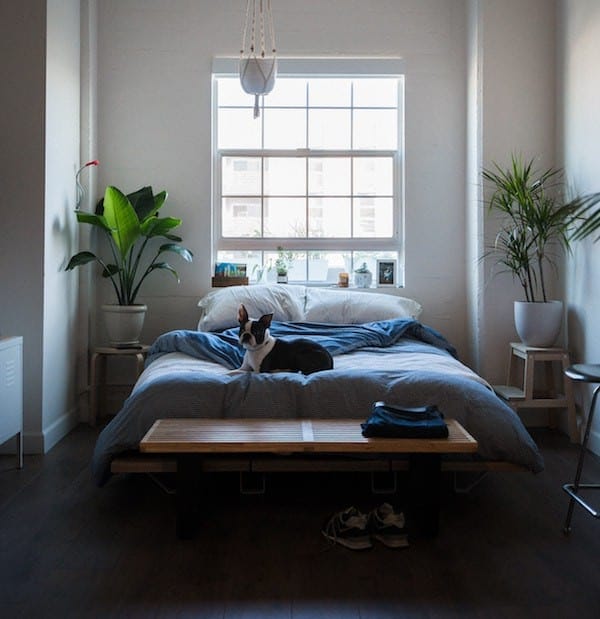
5. Try to Begin Crate Training When You’re Home
Lastly, it’s much easier to introduce your puppy to the crate while you’re home and awake, rather than overnight or right before you go to work.
That’s why, if possible, it’s really best to try to take some serious time off when bringing home a new puppy. Not to mention you want to capitalize on some quality bonding!
If taking time off isn’t possible, see about working from home for a couple of weeks. Crate training your pup without you being home and awake isn’t impossible, but it’s definitely a lot tougher.
Get Help With Crate and Potty Training (If Possible)
Leaving a six-, eight-, or even twelve-week-old puppy in the crate for more than a few hours is a recipe for a crate-crying, crate-peeing situation. Puppies at this age simply don’t have the emotional resilience or the bladder capacity to handle this!
Even adult shelter dogs might really struggle with crate training at first.
While staying home with your pup and slowly introducing mini crate sessions is best, most of us can’t take time off work for our new puppies. That means that sometime soon, you won’t be around while your puppy is in the crate.
If at all possible, get help at this stage. Dog sitters, dog walkers, neighbors, and high school kids are all options to help get your puppy out of the crate as much as possible.
I actually got started as a dog trainer when I was hired to take a super-cute lab puppy named Mabel out of her crate four times per day. Since I was hanging out with Mabel so much, I started training Mabel for fun.
Today, I’m a professional dog trainer, all thanks to Mabel who got me started. Who knows, hiring a local kid could introduce someone to their dream job!
If you can’t get help with crate training your dog, use an exercise pen setup. Put your puppy’s crate, some water, some toys, some chewies, and a puppy litter box inside of the exercise pen on a non-carpeted surface. Many puppies will use the puppy litter box readily because it’s absorbent.
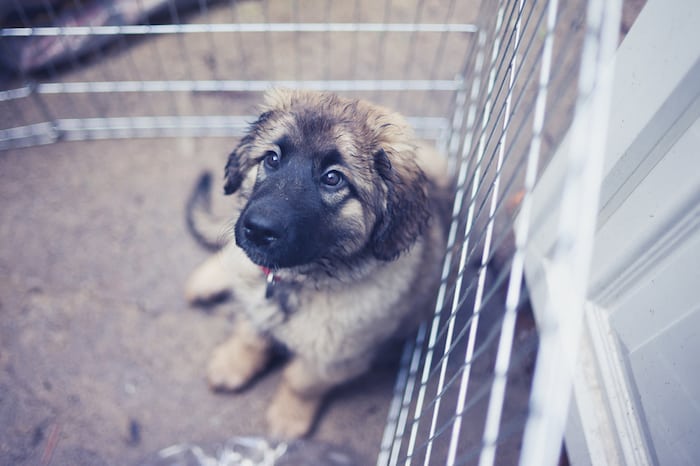
This allows your puppy to have more room during the day and doesn’t teach her to pee inside her crate. It’s hard to break a puppy of peeing in her crate once she’s started!
The general rule of thumb for potty training is that a puppy can hold his bladder for as many hours as he is months old, plus one. So a four-month-old puppy can, in theory, hold his bladder for five hours. That means she’ll need a midnight potty break!
The problem with this formula is that most puppies don’t know they should hold it, so they don’t try. Most puppies also have a shorter capacity to hold their bladders if they’re up and about playing or if they’re small breed dogs.
Crate Training Schedule: Your Puppy’s Timetable
Now that you’ve got either help lined up, are able to be with your puppy, or you’ve got an exercise pen set up, let’s look at an actual crate training schedule.
Of course, some dogs and puppies will move slower or faster than this schedule. Small puppies may take longer at first because of tiny bladders, but they mature faster. Giant breed puppies can actually take longer to “finish” potty training because they mature more slowly physically and mentally.
Some adult dogs will catch onto crate training easily because they are loosely familiar with it from puppyhood, while crate training some adult shelter dogs is a nightmare!
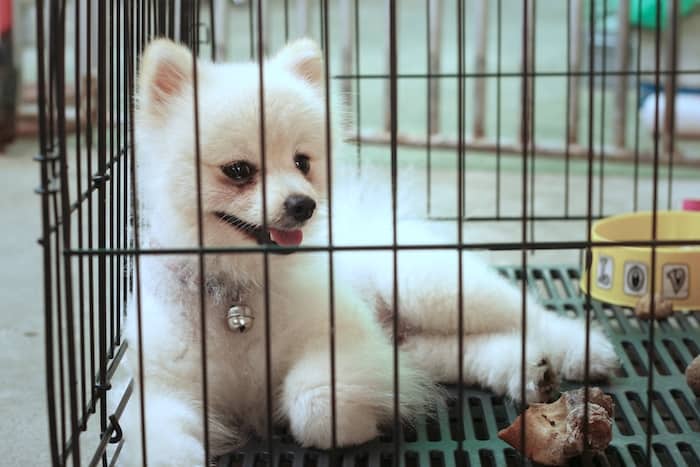
Keeping that in mind, we won’t break this list down by times. Instead, we’ll refer to these as “phases” and you can just move through at your puppy’s pace.
Don’t push past where your puppy is succeeding, and don’t be afraid to “go backward” if your dog starts slipping up.
Through all phases of this plan, keep this rule in mind: if your pup fusses for more than a few seconds or minutes (you know your own puppy better than I do), take her out for an ultra-boring potty break. Then give her a treat and put her back inside. Try not to take her out of the crate for fun things unless she’s quiet — so that might mean putting her back in the crate, then letting her out again before she starts to cry.
Phase One: Introduction
Start with just a few minutes in the crate at a time, using treats. Just reward her for being inside, then take her right out again.
At night or when your puppy is already sleepy, scoop your puppy up and put her inside. Keep the crate in your bedroom at night. If she still cries at night, try elevating the crate to the same level as your bed.
If your puppy can’t tolerate being in the crate, even when it’s at bed-level overnight, you can let her sleep with you and just work on crate training during the day. The downside of this approach is that it’s really hard to later teach your puppy not to sleep with you.
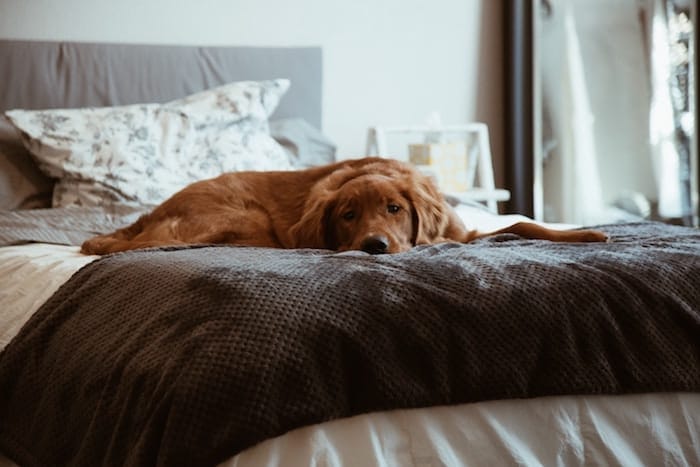
Most puppies will settle after a bit of fussing if you place the crate correctly at night.
Phase Two: Building Tolerance
Start to leave your puppy in the crate while you’re eating dinner, cooking, watching TV, or otherwise “around.” Drop some treats inside every so often, and occasionally get up and leave. Gradually increase those absences.
If your puppy cries the second you put her inside the crate, go back to the first phase where you simply sit with your puppy in the crate and feed your puppy treats.
At this stage, you might need to go back to work. Set up the exercise pen that we described above if your puppy can’t handle the work day yet!
Keep in mind that puppies still need to be let outside every few hours, depending on their age. An awake six-week-old puppy should be going outside for potty every 30 minutes or so! Potty training is practically a full-time job.
Phase Three: Adding Time
Start to leave your puppy in the crate while you’re out of the house.
Set up a recorder if you’re worried — I leave my laptop behind and watch the Photo Booth recording later on. A Furbo dog camera or a Nest will also record your puppy while you’re gone.
This stage is tricky because if your puppy starts to panic or fuss, you won’t be around to help. Try to only leave her for time periods that you’re confident she can handle!
Phase Four: Weaning Off The Crate
Most of us would like our puppies or dogs to be free-ranging in the house ASAP.
You can start to leave your puppy unattended and outside of the crate for short periods of time (like while you’re showering or changing), gradually building up to grocery runs, date night, and work.
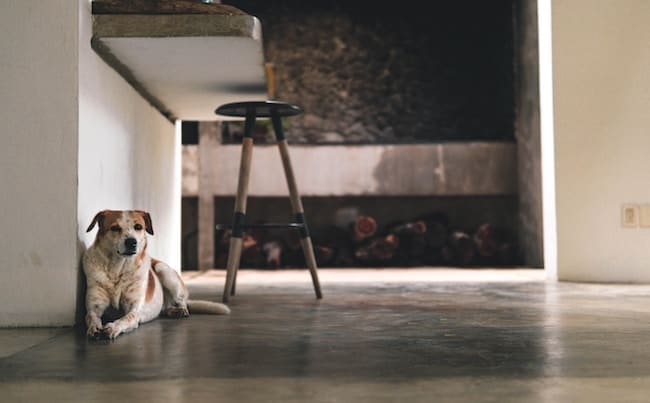
Alternatively, you can start to expand your puppy’s world using the methods described in “Crate Training Alternatives.” That’s my go-to!
If you’d like to ultimately move the crate out of your bedroom, I recommend slowly moving the crate towards its final destination, a few inches per night.
Crate Training Alternatives: Give Your Pup More Space and Keep Your Stuff Safe
If you’re a bit hesitant to crate train your new dog but still want to get the benefits of keeping your stuff (and your dog) safe, there are plenty of other options out there.
Confining your dog to keep chewing and house-soiling at bay does not have to involve a crate.
In fact, there are plenty of other options that give your dog more space and keeps her from eating things she shouldn’t:
- Exercise Pens. These are my go-to favorite solution for either weaning a dog off of a crate or skipping the crate altogether. These little-linked fences allow you to put a crate, bed, toys, litter box (if you’d like), and water inside of a small, dog-proof area. You can even gradually increase the side of their world by propping the ex-pen against walls.
- Extra-Large Crates. If you’re not using a crate for potty training, get the biggest crate you can fit in your space. Tighter quarters are good for preventing your dog from pottying, but if housetraining isn’t an issue, you might as well make your dog’s lounging space luxurious. Your Labrador or Beagle will certainly appreciate his Great Dane-sized crate!
- Connect Two Crates. Many wire crates can be hooked together to create a much larger crate. This is a great option for large dogs or for owners who would like a crate that works in their car and for a roomy confinement area.
- Baby Gates. Sure, some dogs might jump over a baby gate, but for most dogs, these are a cheap and easy option for giving your dog more space. Set up a baby gate to confine Fido to the bathroom, kitchen, or dining room to keep him off the carpet and away from whatever temptations he likes to chew on while you’re away. Like exercise pens, baby gates can allow you to strategically increase space as your pup earns your trust. There are also dog gates designed specifically to keep pooches in certain parts of the house, with easy-to-open doors for you to slide through.
- Closed Doors. Sometimes, keeping your floor and shoes safe from your dog is as easy as closing a door. Don’t do this if you’re worried that your dog will dig at the door, but often you can simply close your new dog in the bedroom or bathroom to give her much more space than a crate. This option generally goes over better with dogs that are used to confinement or don’t have a set routine yet. Closing a dog who’s used to free reign of the house in a single room is likely to elicit crying and digging!
Of course, dog sitters and dog walkers are also great ways to help potty train a dog. Giving your dog good puzzle toys and adequate exercise will also help keep her from chewing on non-toy-objects (like your shoes).
Crate Training Q&A:
What If My Puppy Still Cries All the Time?
I like to use Karen Overall’s Relaxation protocol as a “crate game” for puppies that really struggle. Check out the fifteen-day Karen Overall relaxation protocol here.
Puppies that cry the second they’re put in the crate also might benefit from switching to an exercise pen, where they just don’t have the “bad feelings.”
We wrote a whole piece on crate crying that you can check out here.
What If My Puppy Keeps Peeing in the Crate?
If your puppy continues to pee in the crate, odds are, you’re not letting your puppy out enough OR you’re not rewarding properly when she does pee outside. Be sure to reward your puppy with treats, not just praise.
Take her out frequently and keep her crate clean. If she learns to pee in her crate regularly (a problem in many puppy-mill dogs), the habit can be very hard to break.
Check out our guide to puppies that pee in the crate here.
How Long is Too Long For a Dog to be in a Crate?
If your dog is in the ASPCA-recommended smaller crate size (rather than one of our larger alternatives described above), I personally think that a full workday is too long.
If your dog only has room to turn around and not much more, a midday break is almost certainly necessary.
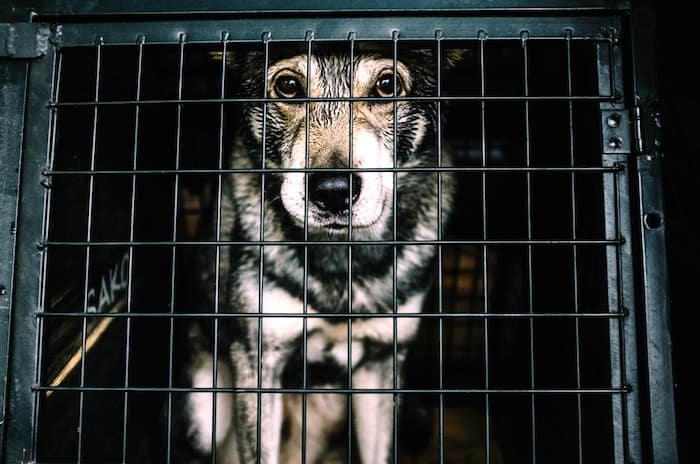
Of course, younger puppies or dogs that aren’t used to the crate might not even be able to stay in the crate for four hours yet. Only leave your dog in the crate for as long as she can handle, and don’t ever push it past four or five hours if at all possible.
If you’re going to need to leave your dog for a full workday without breaks, look at an exercise pen or baby gate setup.
How Long Does It Take to Crate Train a Puppy?
Ah, I wish I could tell you! Some puppies can successfully start training exercises at as early as eight weeks, taking to crate training like a fish to water. Others take to crate training like… well, a cat to water.
I’ve heard of new puppies that are crate trained and “holding it” for four hours within a few weeks. They almost exclusively come from breeders that started the crate training process when they were young.
I’ve also heard of many dogs that never seem to learn to settle in the crate, despite truly valiant efforts from their owners.
In general, expect at least a few days of nighttime crying. You’ll definitely need to sacrifice some sleep to get this process smoothed out.
Daytime crate training may take longer, depending on your puppy’s bladder capacity! No matter how well-behaved your ten-week-old puppy is, she still can only hold her pee for about three hours.
Crate Training at Night vs Crate Training a Puppy While at Work: What’s The Difference?
Many dogs adjust to nighttime crate training much faster than workday crate training. That’s because you’re right there at night, able to take the puppy out if needed.
During the day, your puppy is totally alone. If she’s scared or wants out, no one can rescue her. She can’t smell you or hear your breathing. It’s totally different for some dogs!
Getting help for daytime crate training is almost a must for many people that work full time. Otherwise, you’re just setting your puppy up for a miserable day.
Where Should My Puppy Sleep at Night? In My Bed or a Crate?
Ultimately, this is up to you. Many trainers recommend sleeping with your dog in your room (or even on your bed) to facilitate bonding.
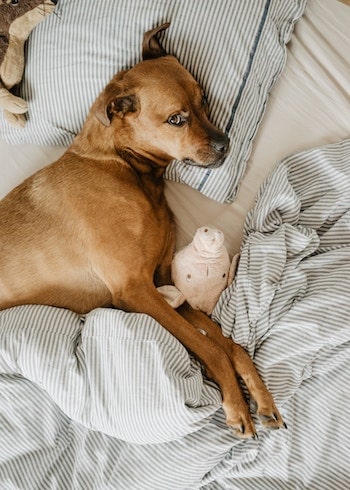
Other trainers discourage co-sleeping as it may lead to resource aggression around the bed (but it’s not going to “make your dog dominant”). There are also some reports that an animal’s movement can disrupt your sleep, even if you think you’re not getting woken up.
There’s little evidence, if any, to show that letting your dog sleep with you causes separation anxiety.
While working on crate training, keeping your puppy in your room is often the best thing to do. You can always move the crate (best done slowly, night over night) to a final sleeping spot once she’s comfortable with the crate!
What crate training tips do you have to share? We love hearing your firsthand wisdom!
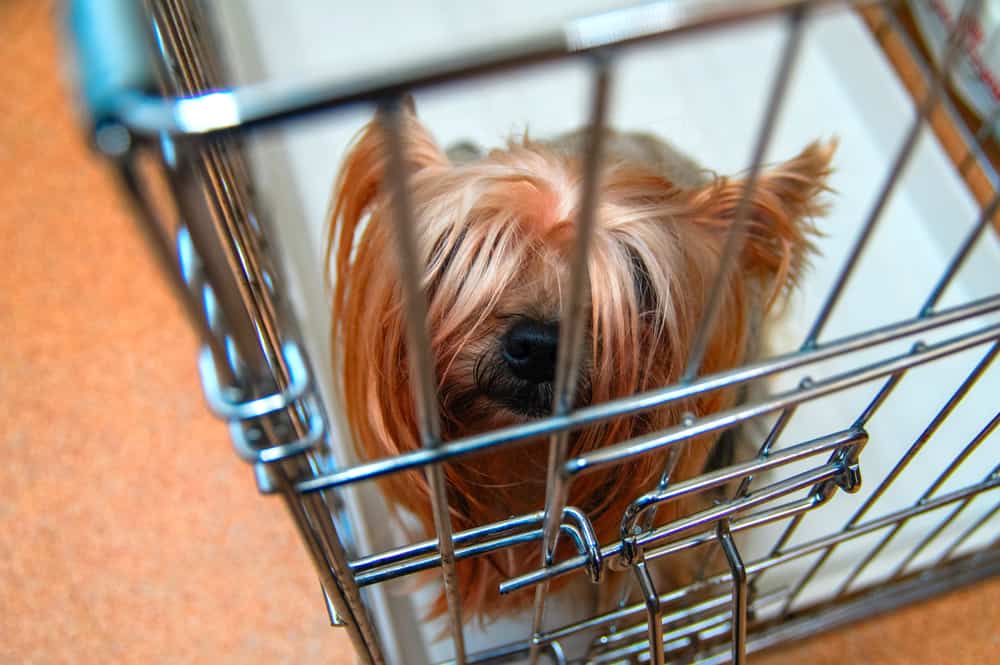



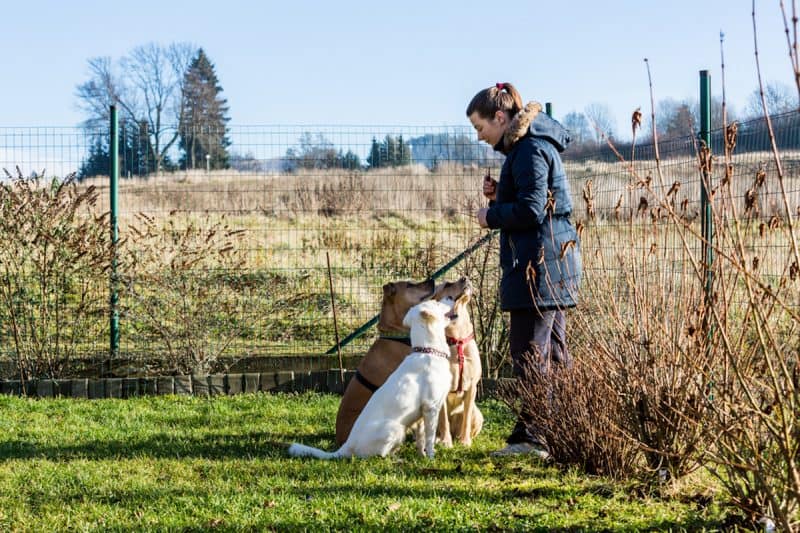
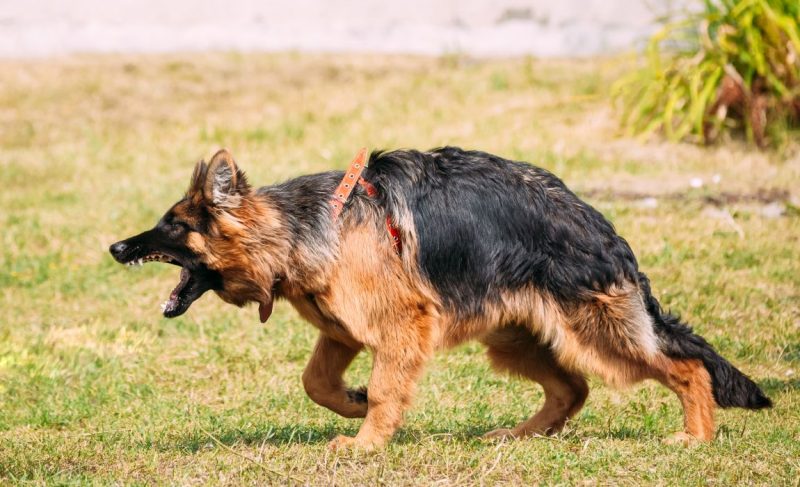
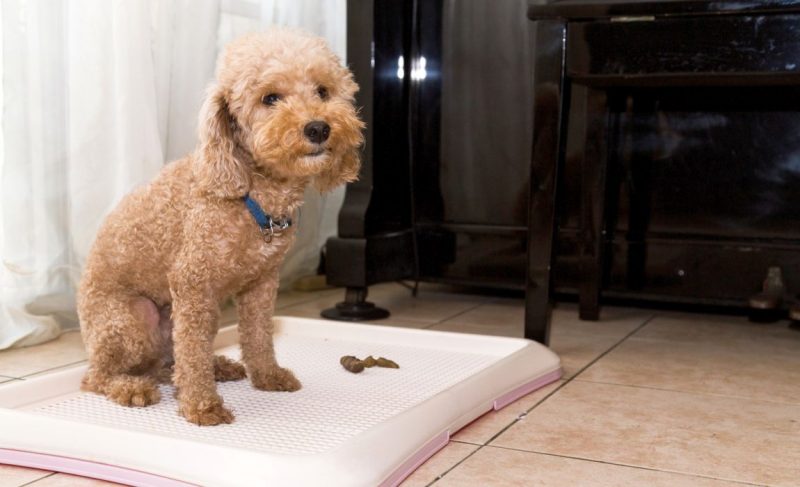

Leave a Comment